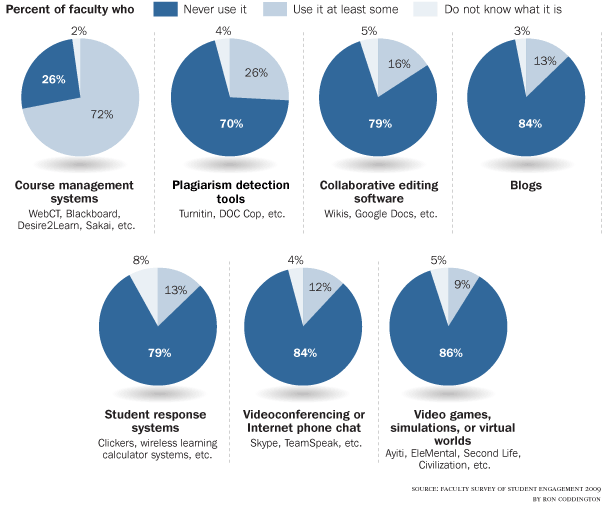10 Knowledge & Practices Teachers Need to Implement New Literacies (i.e., “New Education”)
- Always have a content-purpose underlying any use of technology in the classroom. (like Steven Azeka, social and economic issues of immigration; Patrick Honner’s linear algebra course; Diana Laufenberg’s focus on the State of the Union address; Nicholas Provenzano’s teaching of Romeo and Juliet).
- Design contemporary issues that don’t necessarily have solutions into your content, such as when Kaari Pitkin employs live chats to discuss cyber-bullying, state of education in NY, or gun control; or Jinnie Spiegler’s TeachableMoment, or writing fanfiction or e-zines (Beach, 2012) or engaging as critical researchers addressing problems in LA schools and creating videos on the issues (Beach, 2012); or entire worlds built into serious games that allow for “problems, tools, people, experiences, perspectives and consequences” (Barab et al., 2010, p. 525).
- Put boundaries or frames on the technology-based activities through curricular frames or technological frames, such as when Heather Barikmo has students take pictures of vocabulary and idioms, which is curricularly focused and limited activity; or using Edmondo or Ning or games like Quest Atlantis to sponsor closed social media activity for students (Steven Azeka and Beach (2012) and Barab et al. (2010) all provide examples);
- Not all learning or teaching must include digital technology. Beach (2012) encourages examining the affordances of technologies – such as if a tool/device/app fosters collaborative writing, gaming, sharing etc. Capitalize on these affordances as they assist you in meeting #1 above; otherwise move on.
- Develop a group of colleagues at a distance (who teach in other schools or are experts) that you can get ideas from and/or collaborate with, such as when Shaelynn Farnsworth’s class shares writing or collaboratively develops multimedia expressions or Sarah Gross developed and only recently began to use IN her classroom or Patrick Honner is inspired and mentored by two mathematicians or Nicholas Provenzano and Shawn Hyer’s Epic Romeo and Juliet Project or Meenoo’s creation of the #engchat; or Grace White’s use of Twitter.
- Visit other educators’ classrooms, as Alice Mercer does in Sacramento. If you are unable to do this, then do #5 above even more.
- Listen to your students, explore their interests, and get the pulse on their technological activities. Alvermann, Hutchins, & McDevitt, (2012) emphasize that teachers, librarians, educators must be aware of young people’s digital literacies; Rey Junco in the connected education also emphasizes this; Beach (2012) noted how students are more engaged when creating / engaging in digital activities that involve authentic audiences and purposes (see also #2 above).
- Rethink learning spaces (physical or virtual). Jonathan Olsen reimagined a learning lab. Beach (2012) writes about the idea of learning commons, which positions media centers and classrooms together focused on sharing knowledge and connecting.
- Share your work, especially with your community and parents, to build support. Lisa Doyle Giacomelli uses Facebook to post photos & information about her science classes giving “parents, grandparents, and administrators a window.” (See also #5 above).
- Take risks and learn (as Pam Moran noted).
Please read the earlier post on 4/21/14 for context that led to the creation of this list.
Faculty use of technology: general faculty (chronicle of educ stats) and in teacher education (our stats)
A report from The Chronicle of Higher Education on faculty’s use of technology yielded the following data:
Image Source: The Chronicle of Higher Education; http://chronicle.com/article/Professors-Use-of/123682; June 25, 2010.
Discussion around these data include questions of whether technology makes a better teacher. Certainly an excellent question! We do not believe that using technology will magically make a teacher a better teacher – in fact, at first, many teachers (and university faculty) may face some hiccups as they learn to teacher in a more student-centered way, as many of these technological tools are best used by students to learn. Faculty do not experience hiccups when they adopt technology in support of the usual, teacher-directed pedagogy that we know very well.
We (Joan Hughes with Gloria Gonzales Dholakia, Yu-Chi Wen, and Hyo-Jin Yoon) have a book chapter currently under review called “The iron grip of productivity software within teacher education.” In the chapter, we discuss the importance of faculty modeling of optimal technology use for preservice teachers, as they learn a lot about what they will do as future teachers from what they experience in their teacher preparation program. Yet, we also describe productivity software’s (tools like PowerPoint, word processing, and spreadsheet suites) enduring grip as the most used digital technologies among preservice teachers during teacher education.
The Chronicle’s data (above) reminds us of the data we have collected from preservice teachers. Clearly, there’s ample room to discuss why productivity is emphasized so much (been around a long time, has affordances across disciplinary areas). But we believe an overemphasis on productivity tools is not adequately preparing new teachers for the knowledge society in which we/they live, work, and educate.
We are not faulting teacher education or PK-12 schools or preservice teachers. But we recommend that this focus will not change without concerted change efforts in both teacher education and PK-12 institutions because change in one won’t really have a ripple effect without simultaneous and complementary change in the other.
A glimpse into our data … reveals the high-use digital technology tools by student teachers in 2004-2007 were: email, presentation, search engine, web browser, word processing, and digital movies (student teachers are required to do a lesson study involving video recording their teaching). Overall, data from our student teacher respondents in 2004-2007 and 2008-2009 reflect a low, but emergent use of minimal Web 2.0 tools such as blogs, podcasts, wiki, and social bookmarking. We feel this is a positive trend toward better preparation of teachers to integrate technology into their future PK-12 teaching, but we feel a necessity for more emphasis and progress.
